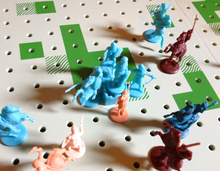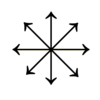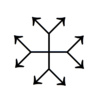Feudal (board game)
| Feudal | |
|---|---|
 Game situation |
|
| Game data | |
| author | Fred Buestchler |
| graphic | not known |
| publishing company |
3M , Avalon Hill , Schmidt Games |
| Publishing year | 1967 |
| Art | Board game, chess variant |
| Teammates | 2 to 6 |
| Duration | 90 minutes |
| Age | from 10 years on |
Feudal is a strategic board game for two people or two teams from 1967 by Fred Buestchler . It is a medieval war simulation with chess elements , in which each of the players gets an army and either has to defeat the opposing ruling family or occupy their castle.
Theme and equipment
The game is a strategic board game with chess elements in which each player has to defeat the opposing army with his army. This succeeds when the opposing ruling family has been defeated or the opposing castle has been occupied.
The game board consists of 24 by 24 fields with holes for placing the game pieces. In addition to the light green meadows, there are also color-coded forest areas and rocks that are marked by hatching on the playing field. The game includes six sets of pawns in six colors, three of which are brown and three are blue. Each set of figures consists of 14 miniatures:
- a king, a prince and a duke (ruling family),
- a castle with a fortified main and unfortified outer bailey,
- two mounted knights,
- two sergeants,
- four javelin throwers,
- a squire and
- an archer.
As in the game of chess , the individual types of pieces have different moves and functions.
Style of play
Game for two people
At the beginning of the game the game board is placed in the middle of the table and the players choose one of the sets of figures; usually blue against brown pieces. The starting player is drawn and chooses which half of the game he wants to start the game on. The playing field is aligned accordingly and the viewing screen is placed in the middle of the field. Both players now place their figures on their half of the game. You may place your castle on any field, including forest or rock fields. Riders (prince, duke and knight) may not be placed on forest or rock fields and may not move over them later. The remaining figures (foot soldiers including the king) are allowed to enter the forest, but not the rocks. All figures may also be placed on one of the two fields of the castle and enter it again later; The exception is the archer, who starts in the castle but is not allowed to enter it later. After both parties have set up their pieces, the game begins.
Starting with the starting player, the two players take turns making a move with each piece they want to move. At least one piece must be moved and the pieces are moved according to the rules for them:
| image | figure | Move | train | number |
|---|---|---|---|---|
 |
king |  |
Infantry; the king can take one step in any direction. | 1 |
 |
prince |  |
All riders can move as many spaces as they like in any direction, but not over woods and rocks. | 1 |
 |
duke |  |
All riders can move as many spaces as they like in any direction, but not over woods and rocks. | 1 |
 |
Knight |  |
All riders can move as many spaces as they like in any direction, but not over woods and rocks. | 2 |
 |
sergeant |  |
Infantry; the sergeant may take one step vertically or horizontally or any number of steps diagonally. | 2 |
 |
Javelin thrower |  |
Infantry; the javelin thrower may take one step diagonally or any number of steps in a vertical or horizontal direction. | 4th |
 |
Squire |  |
Infantry; the squire may move one square horizontally or vertically and one square diagonally in the knight jump . | 1 |
 |
Archer |  |
Infantry; the archer can take up to three steps in any direction. Alternatively, he may stand still and move back the next opposing piece by three squares in any direction. The archer is not allowed to hit figures and he is not allowed to shoot over rocks or a castle. | 1 |
With the exception of the squire, the pieces may not jump over their own or opposing pieces. If the move of a piece ends on an opponent's piece, this piece is captured and removed from the game. The archer may not hit any pieces, only hit back.
A player may not move his piece over another piece and the move may not end on a space already occupied by one of his pieces. If the move ends on a space on which an opposing piece is standing, it is captured and removed from the space. However, it is not allowed to capture on the first move of a piece. When moving, the “touched-guided” rule applies: a figure that has been touched once must be guided on the move, if this is possible.
The game ends when a player succeeds in penetrating the opposing castle or when a player has defeated the opposing ruling family consisting of king, prince and duke.
Game for two teams
In two teams, up to six players can take part in the game. There are always the same number of troops facing each other, if there is an odd number of players, one player takes over two troops.
Each team appoints an Oberfeldherr who leads the respective team. The two commanders receive the darkest troop of the player colors brown and blue and give the other players on their team the lighter figures without castle and ruling family. The commander-in-chief assigns the prince or duke to the allies as leader, after which all players of a team put their troops together on their half of the field. Regardless of the number of players, there can only be one castle and one ruling family on each side.
The rules of the game are the same as those of the game for two people, the generals determine the order of play of their team in each round.
Game for four players
In the game for four players, each player is allocated a quarter of the playing field and places his castle and figures there .; In this case, the instructions form a second visual barrier. Again, the game is played as in the basic game. Players who have lost their castle or ruling family are eliminated along with the castle and royal family, the remaining troops are taken over by their conqueror.
Development and reception
The game Feudal was developed by Fred Buestchler and was published in 1967 in the Bookshelf Games series by 3M in English and in 1969 by 3M in German. After the entire series was sold to Avalon Hill in 1976 , they published another English edition. In 1979 the game appeared in a multilingual version in German, Dutch, Italian and French by Schmidt Spiele .
supporting documents
- ↑ a b c d e f g h game instructions Feudal , 3M 1969
- ↑ Versions of Feudal in the board game database BoardGameGeek (English); accessed on March 15, 2019.
Web links
- Feudally in the game database BoardGameGeek (English)
- Feudal (3M) in the Luding games database
- Feudal (Avalon Hill) in the Luding games database
- Feudal (Schmidt Spiele) in the Luding games database


